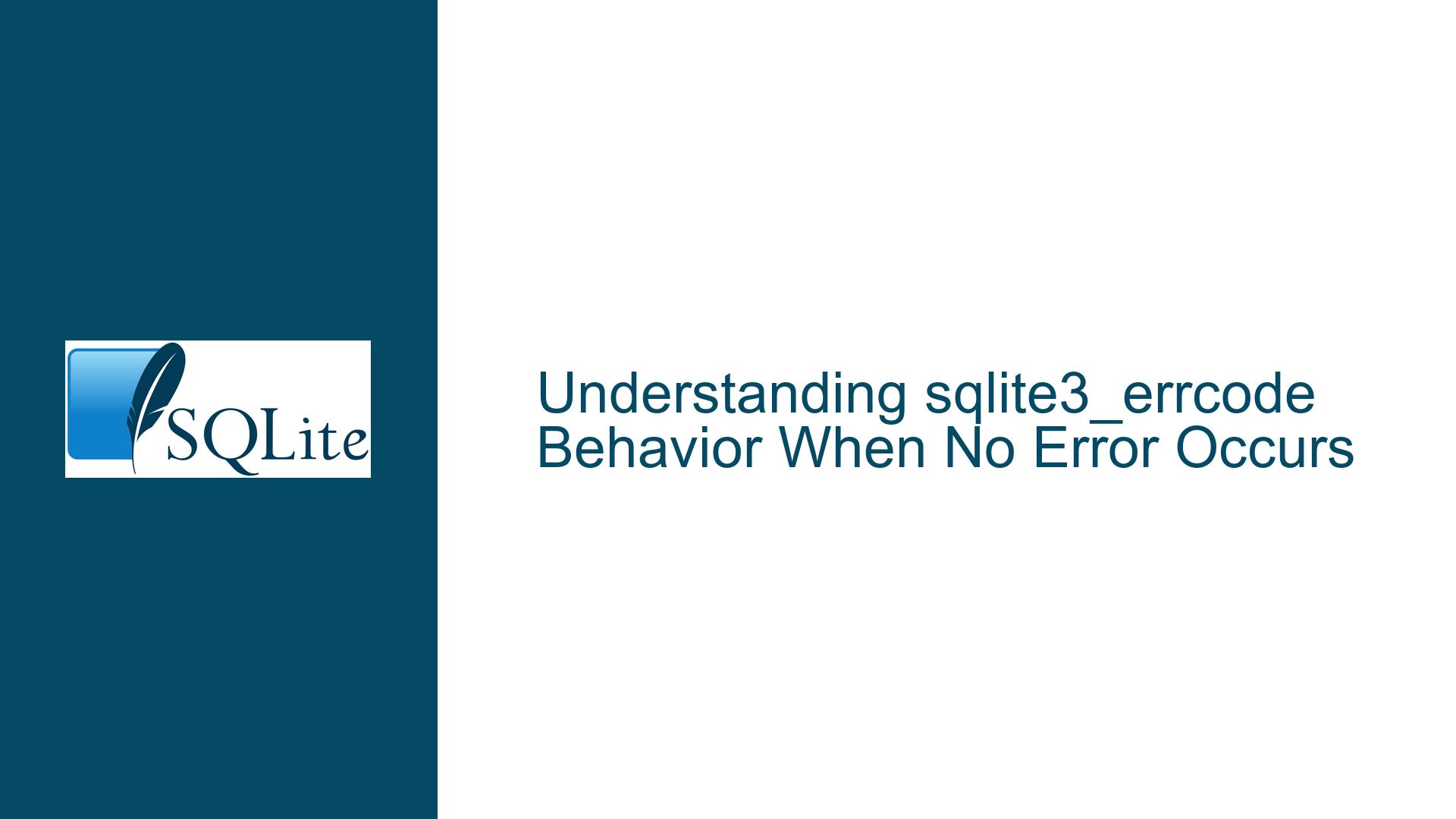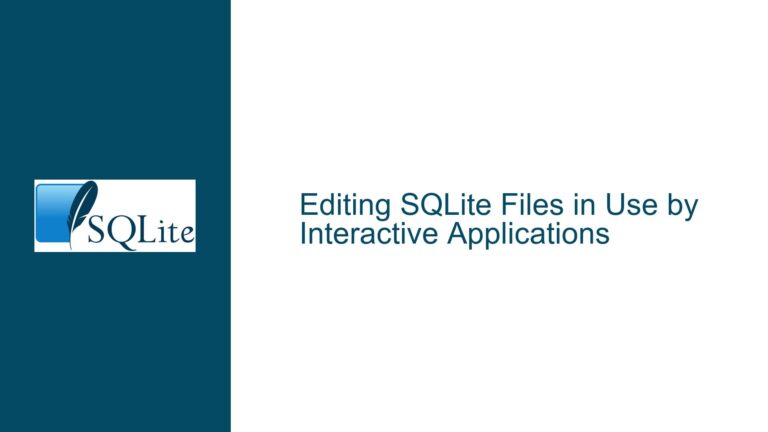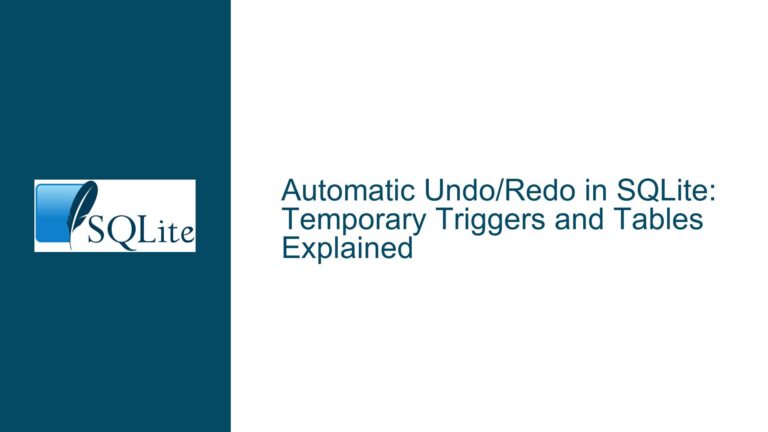sqlite3_errcode Behavior When No Error Occurs
Issue Overview: sqlite3_errcode Behavior in Non-Failure Scenarios
The behavior of the sqlite3_errcode function in SQLite when the most recent API call does not fail is a nuanced topic that warrants a detailed exploration. The sqlite3_errcode function is designed to return the numeric result code or extended result code for the most recent SQLite API call associated with a given database connection, but only if that call failed. The documentation explicitly states this behavior for failure cases but remains silent on what happens when the most recent API call succeeds. This omission has led to confusion among developers, particularly in scenarios where sqlite3_errcode is used as a secondary check to distinguish between valid SQL NULL returns and out-of-memory errors.
The core issue revolves around the ambiguity of sqlite3_errcode‘s return value in non-failure scenarios. Specifically, developers need to know whether the function will return SQLITE_OK, the most recent error code from a prior failed call, or an undefined value. This knowledge is critical when using functions like sqlite3_column_blob, which may return a null pointer both for valid SQL NULL values and for out-of-memory errors. In such cases, sqlite3_errcode is the only way to disambiguate between these two possibilities, as the documentation suggests.
However, the lack of clarity in the documentation has led to differing interpretations and workarounds. Some developers advocate for using sqlite3_column_type to first determine the column’s data type, thereby avoiding the need to call sqlite3_errcode unless absolutely necessary. Others argue that this approach deviates from the documented recommendation and may introduce unnecessary complexity. This divergence in practices underscores the need for a definitive explanation of sqlite3_errcode‘s behavior in non-failure scenarios.
Possible Causes: Ambiguity in sqlite3_errcode’s Non-Failure Behavior
The ambiguity surrounding sqlite3_errcode‘s behavior in non-failure scenarios can be attributed to several factors. First, the SQLite documentation focuses primarily on error handling and recovery, providing detailed information on how to interpret error codes and extended error codes when an API call fails. However, it does not explicitly address the function’s behavior when no error has occurred. This omission creates a gap in the documentation that leaves developers to infer the expected behavior based on context and prior experience.
Second, the design of SQLite’s API encourages developers to check the return status of API calls to determine if a failure has occurred. The sqlite3_errcode function is intended to provide additional diagnostic information in the event of a failure, rather than serving as a primary status check. This design philosophy may explain why the documentation does not explicitly define the function’s behavior in non-failure scenarios. However, this rationale does not account for cases where sqlite3_errcode is used as a secondary check, such as when distinguishing between valid SQL NULL returns and out-of-memory errors.
Third, the behavior of sqlite3_errcode in non-failure scenarios may be influenced by the internal state management of SQLite. SQLite maintains error codes and extended error codes for each database connection, and these codes are updated only when an API call fails. If no failure occurs, the internal state may retain the most recent error code from a prior failed call, or it may be reset to SQLITE_OK. The lack of documentation on this aspect leaves developers uncertain about what to expect when calling sqlite3_errcode after a successful API call.
Finally, the differing interpretations and workarounds proposed by the community reflect the broader challenge of balancing simplicity and robustness in API design. While some developers prefer to rely on sqlite3_column_type to avoid calling sqlite3_errcode unnecessarily, others argue that this approach deviates from the documented recommendation and may introduce additional complexity. This divergence highlights the need for a clear and consistent explanation of sqlite3_errcode‘s behavior in non-failure scenarios.
Troubleshooting Steps, Solutions & Fixes: Clarifying sqlite3_errcode’s Non-Failure Behavior
To address the ambiguity surrounding sqlite3_errcode‘s behavior in non-failure scenarios, developers can take several steps to ensure robust and reliable error handling in their applications. These steps include understanding the function’s intended use, leveraging alternative methods for status checking, and adopting best practices for error handling in SQLite.
First, developers should recognize that sqlite3_errcode is designed to provide additional diagnostic information in the event of a failure, rather than serving as a primary status check. The function’s primary purpose is to return the numeric result code or extended result code for the most recent failed API call associated with a given database connection. As such, it should be used in conjunction with other status-checking mechanisms, such as the return values of API calls, to determine if a failure has occurred.
Second, developers can leverage alternative methods for status checking to avoid relying on sqlite3_errcode in non-failure scenarios. For example, when working with functions like sqlite3_column_blob, developers can use sqlite3_column_type to first determine the column’s data type. If sqlite3_column_type returns SQLITE_NULL, the value is a valid SQL NULL, and there is no need to call sqlite3_errcode. If sqlite3_column_type returns a different value, developers can proceed with calling the appropriate type-specific API, such as sqlite3_column_int64 or sqlite3_column_double, to extract the value. This approach eliminates the need to call sqlite3_errcode unless an out-of-memory error is suspected.
Third, developers should adopt best practices for error handling in SQLite to ensure robust and reliable applications. These best practices include checking the return values of API calls to determine if a failure has occurred, using sqlite3_errcode to obtain additional diagnostic information in the event of a failure, and avoiding unnecessary calls to sqlite3_errcode in non-failure scenarios. By following these best practices, developers can minimize the risk of encountering undefined behavior and ensure that their applications handle errors gracefully.
Finally, developers can contribute to the SQLite documentation by providing feedback and suggestions for improvement. The SQLite project welcomes contributions from the community, and developers can submit patches or documentation updates to clarify the behavior of sqlite3_errcode in non-failure scenarios. By working together, the community can help ensure that the SQLite documentation remains accurate, comprehensive, and up-to-date.
In conclusion, the behavior of sqlite3_errcode in non-failure scenarios is a nuanced topic that requires careful consideration. By understanding the function’s intended use, leveraging alternative methods for status checking, adopting best practices for error handling, and contributing to the SQLite documentation, developers can ensure robust and reliable applications that handle errors gracefully. While the current documentation may leave some questions unanswered, the SQLite community is well-equipped to address these challenges and continue building high-quality software.






